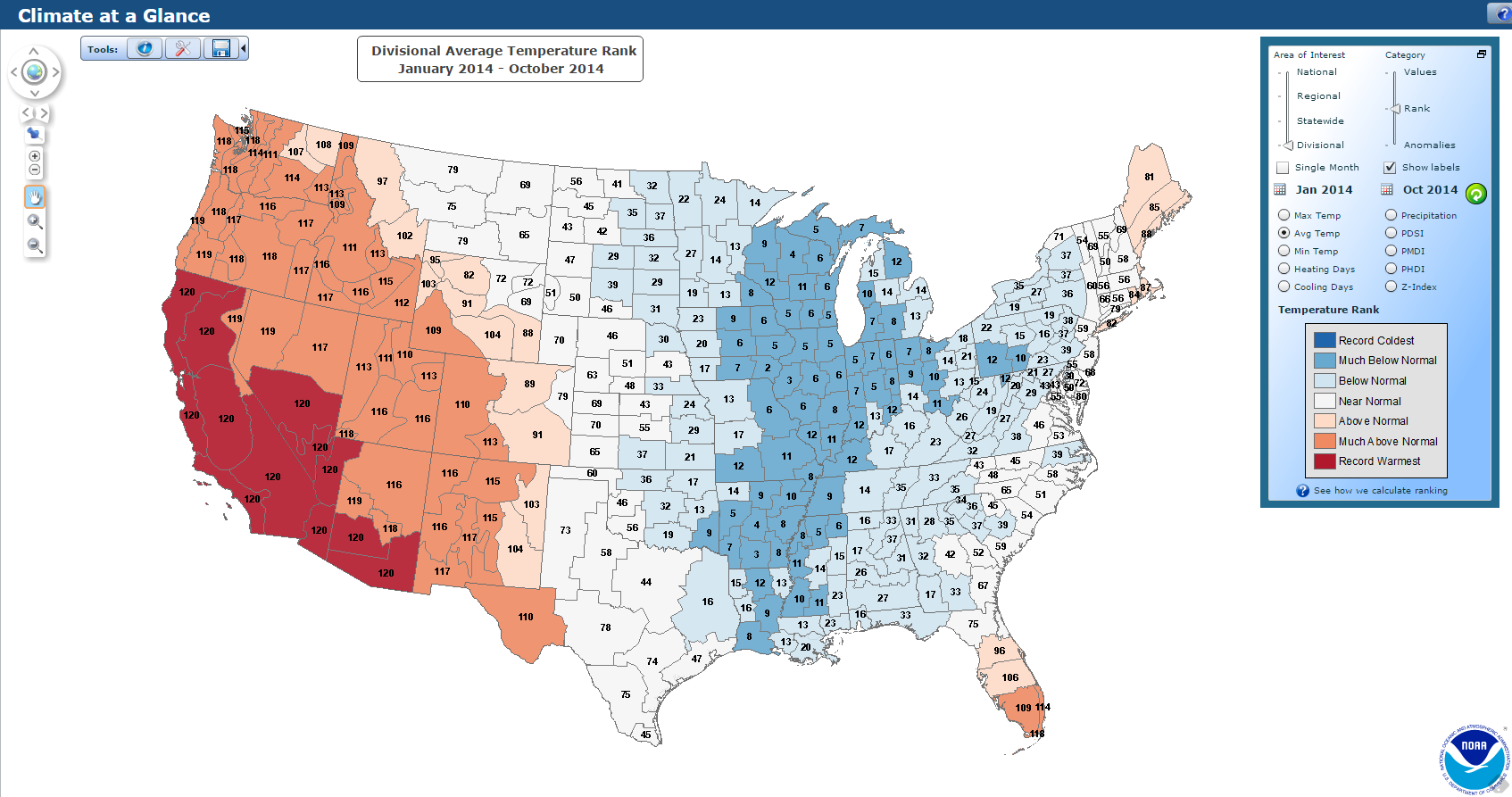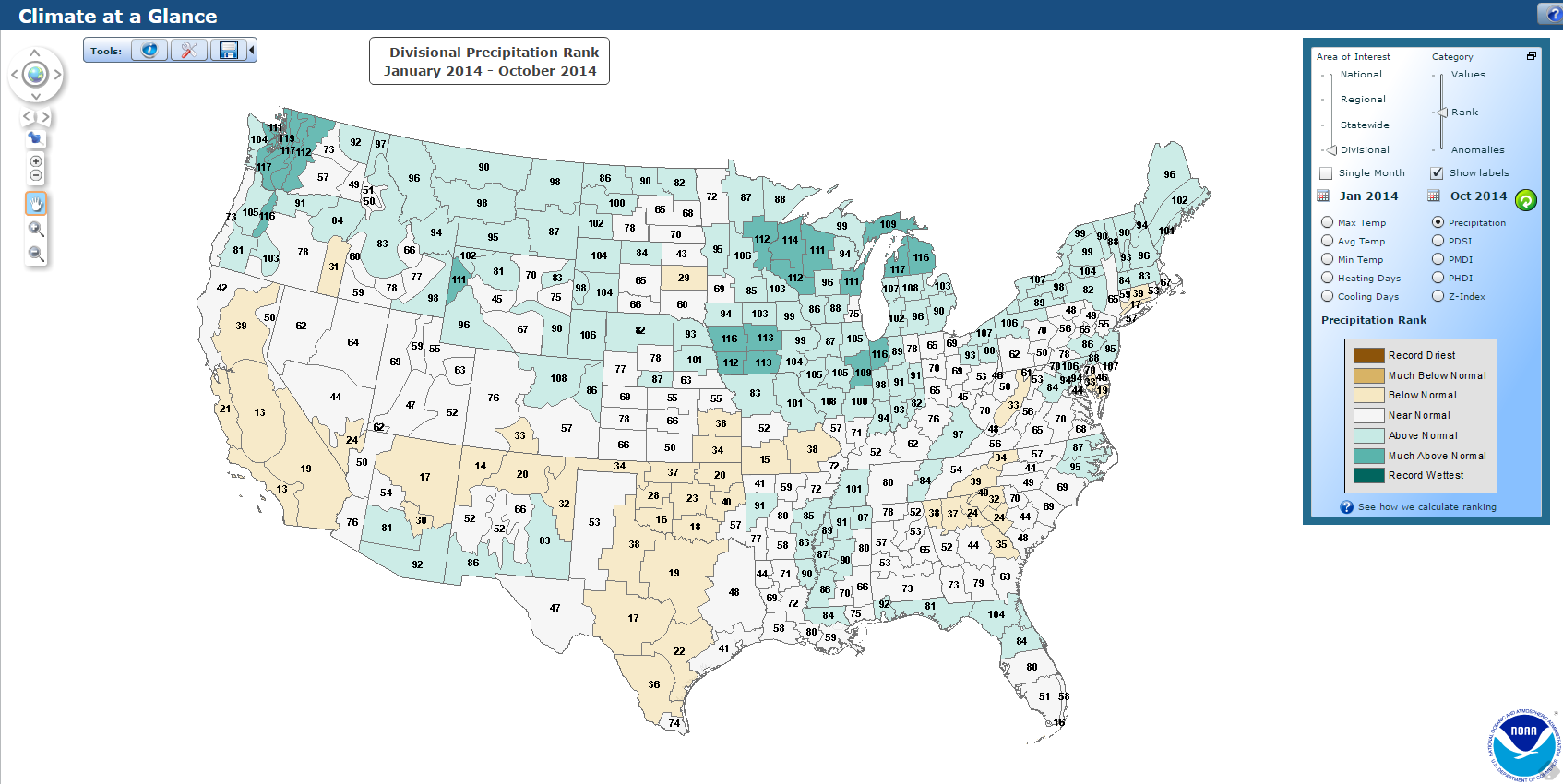I could see this one coming. While Illinois had its 6th coldest year on record, three major groups (Japan, NASA, and NOAA) have noted that 2014 was the warmest year on record. Check out this map from NOAA of the temperature departures for 2014 (red is warmer, blue is cooler). The area from the Great Lakes and southward to the Gulf of Mexico was the only place over land that was colder than average. All the other land masses and most of the ocean surface was warmer than average. In other words, relatively speaking, Illinois was one of the coldest places on earth in 2014. Continue reading “2014 – Warmest on Record for World, 6th Coldest for Illinois. Wait, What?”
2014 – 4th Coldest Year on Record for Illinois
Annual temperature in Illinois
Based on preliminary numbers, 2014 was the 4th coldest year on record for Illinois. The statewide average temperature was 49.4° F and 2.9° F below average. It was tied with 1912 and 1979 for fourth place. The statewide records go back to 1895. Here is the breakdown for the four coldest:
- 1917: 48.3° F
- 1904: 48.9° F
- 1924: 49.2° F
- 1912, 1979, and 2014: 49.4° F
What happened to global warming?
Continue reading “2014 – 4th Coldest Year on Record for Illinois”
January through October – 6th coolest and 19th wettest for Illinois
For the period from January through October, the statewide temperature for Illinois was 52.5 degrees, a full 3 degrees below the long-term average of 1981-2010 and the sixth coolest year to date on record with those records going back to 1895. The five colder years were 1904, 1917, 1979, 1912, and 1978.
Of course, you may ask how can we be so cold during a phase of global warming. There are two answers to that. One is that most of the cold weather for 2014 was confined to the central US. While we were cold in the central US, the western US was much warmer than average.

… and the central US may go down as one of the few cold spots on average, of any place on earth for 2014 so far (see the blue patch on the global map below).

In addition, while 2014 has been colder than average in Illinois (last dot on the time series plot below), it has been the exception to the rule since the early 1980’s.

PRECIPITATION
For the same period, the statewide precipitation was 37.47 inches, 3.67 inches above average and the 19th wettest on record. It was a very wet year so far across much of the rest of the Midwest/Great Lakes region, except for dryness in KS and MO.

Below are the monthly temperature and precipitation departures by month for Illinois in 2014. Below the bar plots are the data used in the plots.
For temperature, January, February, and March were exceptionally cold, as was July. April, May, June, August, and October were much closer to average.
For precipitation, we had an interesting bipolar pattern of a dry month followed by a wet month that continued all the way to August before things became consistently wet through October.
*These numbers are preliminary and may change a little as more data comes in.
| Year | Month | Temperature | Normal | Depart |
| 2014 | Jan | 19.3 | 26.4 | -7.1 |
| 2014 | Feb | 19.4 | 30.9 | -11.5 |
| 2014 | Mar | 34.4 | 41.3 | -6.9 |
| 2014 | Apr | 52.4 | 52.6 | -0.2 |
| 2014 | May | 63.6 | 62.7 | 0.9 |
| 2014 | Jun | 73.0 | 71.9 | 1.1 |
| 2014 | Jul | 70.3 | 75.4 | -5.1 |
| 2014 | Aug | 73.7 | 73.6 | 0.1 |
| 2014 | Sep | 64.7 | 66.2 | -1.5 |
| 2014 | Oct | 54.4 | 54.4 | 0.0 |
| 2014 | Nov | 42.5 | ||
| 2014 | Dec | 29.9 | ||
| Year | Month | Precipitation | Normal | Depart |
| 2014 | Jan | 1.72 | 2.07 | -0.35 |
| 2014 | Feb | 2.22 | 2.06 | 0.16 |
| 2014 | Mar | 1.46 | 2.96 | -1.50 |
| 2014 | Apr | 5.15 | 3.78 | 1.37 |
| 2014 | May | 3.29 | 4.60 | -1.31 |
| 2014 | Jun | 6.77 | 4.21 | 2.56 |
| 2014 | Jul | 3.30 | 4.08 | -0.78 |
| 2014 | Aug | 5.20 | 3.59 | 1.61 |
| 2014 | Sep | 4.08 | 3.23 | 0.85 |
| 2014 | Oct | 4.28 | 3.24 | 1.04 |
| 2014 | Nov | 3.47 | ||
| 2014 | Dec | 2.69 |



